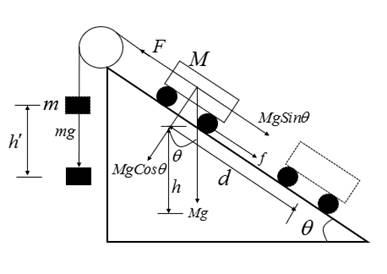
(a) For the car going up the incline, what percentage of the work done by the suspended weight was lost to friction? (b) For the car moving down the incline, what percentage of the work done by gravity was lost to friction? (Show your calculations.)

(a)
The percentage of work done by the suspended weight that is lost to friction when a car is moving up an incline with constant speed.
Answer to Problem 3Q
The percentage loss of energy by the suspended weight is
Explanation of Solution
Draw a diagram to show the different components of forces acting on the car.

Write the expression for the net horizontal force acting on the car
Here,
Write the expression for the force acted upon the car by the pull of the mass
Here,
Write the expression for the work done by the frictional force.
Here,
Write the expression for the percentage loss of energy.
Here,
Write the expression for the work done by the suspended weight.
Here,
Conclusion:
Substitute
Substitute
Substitute
For
Substitute
Substitute
Divide expression (VII) by (VI).
Here,
Substitute
For
Substitute
Substitute
Divide expression (IX) by (VIII).
Here,
Substitute
Thus, the percentage loss of energy by the suspended weight is
(b)
The percentage of work done by gravity that is lost to friction when a car is moving down an incline with constant speed.
Answer to Problem 3Q
The percentage loss of energy by gravity is
Explanation of Solution
Draw a diagram to show the different components of forces acting on the car.

Write the expression for the net horizontal force acting on the car
Here,
Write the expression for the force acted upon the car by the pull of the mass
Here,
Write the expression for the work done by the frictional force.
Here,
Write the expression for the percentage loss of energy.
Here,
Write the expression for the work done by the suspended weight.
Here,
Conclusion:
Substitute
Substitute
Substitute
For
Substitute
Here,
Substitute
Divide expression (XVII) by (XVI).
Here,
Substitute
Here,
For
Substitute
Here,
Substitute
Divide expression (XIX) by (XVIII).
Here,
Substitute
Here,
Thus, the percentage loss of energy by gravity is
Want to see more full solutions like this?
Chapter 12 Solutions
Physics Laboratory Experiments
- What is the dominant factor that affects the speed of an object that started from rest down a frictionless incline if the only work done on the object is from gravitational forces?arrow_forwardThe surface of the preceding problem is modified so that the coefficient of kinetic friction is decreased. The same horizontal force is applied to the crate, and after being pushed 8.0 m, its speed is 5.0 m/s. How much work is now done by the force of friction? Assume that the crate starts at rest.arrow_forwardShown below is a 40-kg crate that is pushed at constant velocity a distance 8.0 m along a 30 Incline by the horizontal force . The coefficient of kinetic friction between the crate and the incline is k=0.40 . Calculate the work done by (a) the applied force, (b) the frictional force, (c) the gravitational force, and (d) the net force.arrow_forward
- Repeat the preceding problem, but this time, suppose that the work done by air resistance cannot be ignored. Let the work done by the air resistance when the skier goes from A to B along the given hilly path be —2000 J. The work done by air resistance is negative since the air resistance acts in the opposite direction to the displacement. Supposing the mass of the skier is 50 kg, what is the speed of the skier at point B ?arrow_forwardIf the net work done by external forces on a particle is zero, which of the following statements about the particle must be true? (a) Its velocity is zero. (b) Its velocity is decreased. (c) Its velocity is unchanged. (d) Its speed is unchanged. (e) More information is needed.arrow_forwardWhat average power is generated by a 70.0-kg mountain climber who climbs a summit of height 325 m in 95.0 min? (a) 39.1 W (b) 54.6 W (c) 25.5 W (d) 67.0 W (e) 88.4 Warrow_forward
- A mouse of mass 200 g falls 100 m down a vertical mine shaft and lands at the bottom with a speed of 8.0 m/s. During its fall, how much work is done on the mouse by air resistance?arrow_forwardAs a young man, Tarzan climbed up a vine to reach his tree house. As he got older, he decided to build and use a staircase instead. Since the work of the gravitational force mg is path Independent, what did the King of the Apes gain in using stairs?arrow_forwardThe force F(x) varies with position, as shown beolow Find the work done by this force on a particle as It moves from x=1.0 m to x=5.0 m.arrow_forward
- Consider a particle on which a force acts that depends on the position of the particle. This force is given by . Find the work done by this force when the particle moves from the origin to a point 5 meters to the right on the x-axis.arrow_forwardA boy in a wheelchair (total mass 47.0 kg) has speed 1.40 m/s at the crest of a slope 2.60 m high and 12.4 m long. At the bottom of the slope his speed is 6.20 m/s. Assume air resistance and rolling resistance can be modeled as a constant friction force of 41.0 N. Find the work he did in pushing forward on his wheels during the downhill ride.arrow_forwardA 5.0-kg box rests on a horizontal surface. The coefficient of kinetic friction between the box and surface is K=0.50 . A horizontal force pulls the box at constant velocity for 10 cm. Find the work done by (a) the applied horizontal force, (b) the frictional force, and (c) the net force.arrow_forward
 University Physics Volume 1PhysicsISBN:9781938168277Author:William Moebs, Samuel J. Ling, Jeff SannyPublisher:OpenStax - Rice University
University Physics Volume 1PhysicsISBN:9781938168277Author:William Moebs, Samuel J. Ling, Jeff SannyPublisher:OpenStax - Rice University Principles of Physics: A Calculus-Based TextPhysicsISBN:9781133104261Author:Raymond A. Serway, John W. JewettPublisher:Cengage Learning
Principles of Physics: A Calculus-Based TextPhysicsISBN:9781133104261Author:Raymond A. Serway, John W. JewettPublisher:Cengage Learning Physics for Scientists and Engineers: Foundations...PhysicsISBN:9781133939146Author:Katz, Debora M.Publisher:Cengage Learning
Physics for Scientists and Engineers: Foundations...PhysicsISBN:9781133939146Author:Katz, Debora M.Publisher:Cengage Learning Physics for Scientists and Engineers, Technology ...PhysicsISBN:9781305116399Author:Raymond A. Serway, John W. JewettPublisher:Cengage Learning
Physics for Scientists and Engineers, Technology ...PhysicsISBN:9781305116399Author:Raymond A. Serway, John W. JewettPublisher:Cengage Learning Glencoe Physics: Principles and Problems, Student...PhysicsISBN:9780078807213Author:Paul W. ZitzewitzPublisher:Glencoe/McGraw-Hill
Glencoe Physics: Principles and Problems, Student...PhysicsISBN:9780078807213Author:Paul W. ZitzewitzPublisher:Glencoe/McGraw-Hill




